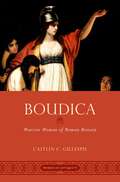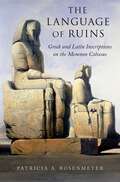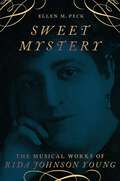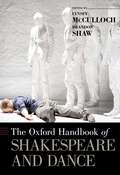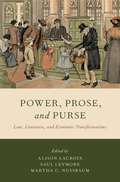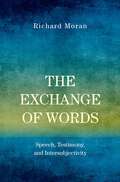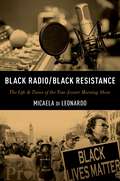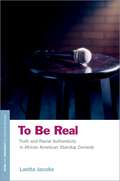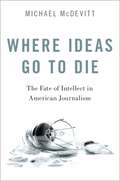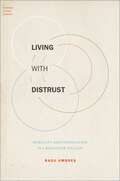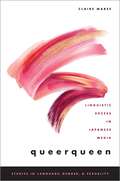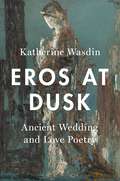- Table View
- List View
We Are Not One People: Secession and Separatism in American Politics Since 1776
by Michael J. Lee R. Jarrod AtchisonE pluribus unum was suggested for the national seal in 1776, but national oneness has been haunted by its opposite ever since. We Are Not One People demonstrates how the persistence of separatist movements in American history reveals as much about the nation's politics as it does the would-be separatists. Each chapter explores how great swaths of Americans of every ideological stripe, in good times and bad, in and beyond the South, have disputed the nation's oneness and stressed its divisibility. Trumpeted in American myths, mottos, movies, and songs, separatism is omnipresent in American political culture. Separatist rhetoric has shaped Americans' experience of what it means to be an American, and we can learn much about the durable appeal and enduring fragility of the United States from those who tried to leave it. As one Vermont separatist quips, leaving is as American "as apple pie." We Are Not One People is a bold, pathbreaking, and far-reaching account of disunionists from 1776 to the present who wanted, as phrased in the Declaration of Independence, "to dissolve the political bands" connecting them to other Americans.
Boudica: Warrior Woman of Roman Britain (Women in Antiquity)
by Caitlin C. GillespieIn AD 60/61, Rome almost lost the province of Britain to a woman. Boudica, wife of the client king Prasutagus, fomented a rebellion that proved catastrophic for Camulodunum (Colchester), Londinium (London), and Verulamium (St Albans), destroyed part of a Roman legion, and caused the deaths of an untold number of veterans, families, soldiers, and Britons. Yet with one decisive defeat, her vision of freedom was destroyed, and the Iceni never rose again. Boudica: Warrior Woman of Roman Britain introduces readers to the life and literary importance of Boudica through juxtaposing her different literary characterizations with those of other women and rebel leaders. This study focuses on our earliest literary evidence, the accounts of Tacitus and Cassius Dio, and investigates their narratives alongside material evidence of late Iron Age and early Roman Britain. Throughout the book, Caitlin Gillespie draws comparative sketches between Boudica and the positive and negative examples with which readers associate her, including the prophetess Veleda, the client queen Cartimandua, and the rebel Caratacus. Literary comparisons assist in the understanding of Boudica as a barbarian, queen, mother, commander in war, and leader of revolt. Within the ancient texts, Boudica is also used as an internal commentator on the failures of the emperor Nero, and her revolt epitomizes ongoing conflicts of gender and power at the end of the Juilio-Claudian era. Both literary and archaeological sources point towards broader issues inherent in the clash between Roman and native cultures. Boudica's unique ability to unify disparate groups of Britons cemented her place in the history of Roman Britain. While details of her life remain elusive, her literary character still has more to say.
The Language of Ruins: Greek and Latin Inscriptions on the Memnon Colossus
by Patricia A. RosenmeyerA colossal statue, originally built to honor an ancient pharaoh, still stands today in Egyptian Thebes, with more than a hundred Greek and Latin inscriptions covering its lower surfaces. Partially damaged by an earthquake, and later re-identified as the Homeric hero Memnon, it was believed to "speak" regularly at daybreak. By the middle of the first century CE, tourists flocked to the colossus of Memnon to hear the miraculous sound, and left behind their marks of devotion (proskynemata): brief acknowledgments of having heard Memnon's cry; longer lists by Roman administrators; and more elaborate elegiac verses by both amateur and professional poets. The inscribed names left behind reveal the presence of emperors and soldiers, provincial governors and businessmen, elite women and military wives, and families with children. While recent studies of imperial literature acknowledge the colossus, few address the inscriptions themselves. This book is the first critical assessment of all the inscriptions considered in their social, cultural, and historical context. The Memnon colossus functioned as a powerful site of engagement with the Greek past, and appealed to a broad segment of society. The inscriptions shed light on contemporary attitudes toward sacred tourism, the role of Egypt in the Greco-Roman imagination, and the cultural legacy of Homeric epic. Memnon is a ghost from the Homeric past anchored in the Egyptian present, and visitors yearned for a "close encounter" that would connect them with that distant past. The inscriptions thus idealize Greece by echoing archaic literature in their verses at the same time as they reflect their own historical horizon. These and other subjects are expertly explored in the book, including a fascinating chapter on the colossus's post-classical life when the statue finds new worshippers among Romantic artists and poets in nineteenth-century Europe.
The Puritan Cosmopolis: The Law of Nations and the Early American Imagination (Oxford Studies in American Literary History)
by Nan GoodmanThe Puritan Cosmopolis traces a sense of kinship that emerged from within the larger realm of Puritan law and literature in late seventeenth-century New England. Nan Goodman argues that these early modern Puritans-connected to the cosmopolis in part through travel, trade, and politics-were also thinking in terms that went beyond feeling affiliated with people in remote places, or what cosmopolitan theorists call "attachment at a distance." In this way Puritan writers and readers were not simply learning about others, but also cultivating an awareness of themselves as ethically related to people all around the world. Such thought experiments originated and advanced through the law, specifically the law of nations, a precursor to international law and an inspiration for much of the imagination and literary expression of cosmopolitanism among the Puritans. The Puritan Cosmopolis shows that by internalizing the legal theories that pertained to the world writ large, the Puritans were able to experiment with concepts of extended obligation, re-conceptualize war, contemplate new ways of cultivating peace, and rewrite the very meaning of Puritan living. Through a detailed consideration of Puritan legal thought, Goodman provides an unexpected link between the Puritans, Jews, and Ottomans in the early modern world and reveals how the Puritan legal and literary past relates to present concerns about globalism and cosmopolitanism.
Sweet Mystery: The Musical Works of Rida Johnson Young (Broadway Legacies)
by Ellen M. PeckRida Johnson Young (ca. 1869-1926) was one of the most prolific female playwrights of her time, as well as a lyricist and librettist in the musical theater. She wrote more than thirty full-length plays, operettas, and musical comedies, 500 songs, and four novels, including Naughty Marietta, Lady Luxury, The Red Petticoat, and When Love is Young . Despite her extensive output, no significant study of her work has been produced. This book looks at her musical theater works with in-depth analyses of her librettos and lyrics, as well as her working relationships with other writers, performers, and producers, particularly Lee and J. J. Shubert. Using archival materials such as original typescripts, correspondence, and reviews, the book contextualizes her work in the early twentieth century professional theater and provides a window into the standard practices of writing and production of the era.
Sweet Mystery: The Musical Works of Rida Johnson Young (Broadway Legacies)
by Ellen M. PeckRida Johnson Young (ca. 1869-1926) was one of the most prolific female playwrights of her time, as well as a lyricist and librettist in the musical theater. She wrote more than thirty full-length plays, operettas, and musical comedies, 500 songs, and four novels, including Naughty Marietta, Lady Luxury, The Red Petticoat, and When Love is Young . Despite her extensive output, no significant study of her work has been produced. This book looks at her musical theater works with in-depth analyses of her librettos and lyrics, as well as her working relationships with other writers, performers, and producers, particularly Lee and J. J. Shubert. Using archival materials such as original typescripts, correspondence, and reviews, the book contextualizes her work in the early twentieth century professional theater and provides a window into the standard practices of writing and production of the era.
The Oxford Handbook of Shakespeare and Dance (Oxford Handbooks)
by Lynsey Mcculloch and Brandon ShawShakespeare's texts have a long and close relationship with many different types of dance, from dance forms referenced in the plays to adaptations across many genres today. With contributions from experienced and emerging scholars, this handbook provides a concise reference on dance as both an integral feature of sixteenth- and seventeenth-century culture and as a means of translating Shakespearean text into movement - a process that raises questions of authorship and authority, cross-cultural communication, semantics, embodiment, and the relationship between word and image. Motivated by growing interest in movement, materiality, and the body, The Oxford Handbook of Shakespeare and Dance is the first collection to examine the relationship between William Shakespeare - his life, works, and afterlife - and dance. In the handbook's first section - Shakespeare and Dance - authors consider dance within the context of early modern life and culture and investigate Shakespeare's use of dance forms within his writing. The latter half of the handbook - Shakespeare as Dance - explores the ways that choreographers have adapted Shakespeare's work. Chapters address everything from narrative ballet adaptations to dance in musicals, physical theater adaptations, and interpretations using non-Western dance forms such as Cambodian traditional dance or igal, an indigenous dance form from the southern Philippines. With a truly interdisciplinary approach, The Oxford Handbook of Shakespeare and Dance provides an indispensable resource for considerations of dance and corporeality on Shakespeare's stage and the early modern era.
POWER,PROSE & PURSE C: Law, Literature, and Economic Transformations
by Saul Levmore and Martha C. NussbaumFrom Anthony Trollop to Sinclair Lewis, and from Jane Austen to James Joyce and John Steinbeck, many important novels touch on fundamental questions about the role of money in human affairs. These questions are explored in this volume through the lens of law and literature. The sixteen essays collected here, by important theorists from a range of disciplines, shed new light on the impact of economic change, from the Industrial Revolution to the Great Depression. Students of economics and business will gain a new appreciation of literature's insights on singular events and human emotions. Similarly, scholars and students of literature will gain an appreciation for the power of law and economics to inform literary and social analysis. The volume's focus on novels about money and economic upheaval showcases the power of the disciplinary marriage of law and literature.
Power, Prose, and Purse: Law, Literature, and Economic Transformations
From Anthony Trollop to Sinclair Lewis, and from Jane Austen to James Joyce and John Steinbeck, many important novels touch on fundamental questions about the role of money in human affairs. These questions are explored in this volume through the lens of law and literature. The sixteen essays collected here, by important theorists from a range of disciplines, shed new light on the impact of economic change, from the Industrial Revolution to the Great Depression. Students of economics and business will gain a new appreciation of literature's insights on singular events and human emotions. Similarly, scholars and students of literature will gain an appreciation for the power of law and economics to inform literary and social analysis. The volume's focus on novels about money and economic upheaval showcases the power of the disciplinary marriage of law and literature.
EXCHANGE OF WORDS C: Speech, Testimony, and Intersubjectivity
by Richard MoranThe capacity to speak is not only the ability to pronounce words, but the socially-recognized capacity to make one's words count in various ways. We rely on this capacity whenever we tell another person something and expect to be believed, and what we learn from others in this way is the basis for most of what we take ourselves to know about the world. In The Exchange of Words, Richard Moran provides a philosophical exploration of human testimony as a form of intersubjective understanding in which speakers communicate by making themselves accountable for the truth of what they say. The book brings together themes from literature, philosophy of language, moral psychology, action theory, and epistemology, for a new approach to this fundamental human phenomenon. The account developed here starts from the difference between what may be revealed in one's speech (like a regional accent) and what we explicitly claim and make ourselves answerable for. Some prominent themes include: the meaning of sincerity in speech, the nature of mutuality and how it differs from 'mind-reading', the interplay between the first-person and the second-person perspectives in conversation, and the nature of the speech act of telling and related illocutions as developed by philosophers such as J. L. Austin and Paul Grice. Everyday dialogue is the locus of a kind of intersubjective understanding that is distinctive of the transmission of reasons in human testimony, and The Exchange of Words is an original and integrated account of this basic way of being informative to and in touch with one another.
The Exchange of Words: Speech, Testimony, and Intersubjectivity
by Richard MoranThe capacity to speak is not only the ability to pronounce words, but the socially-recognized capacity to make one's words count in various ways. We rely on this capacity whenever we tell another person something and expect to be believed, and what we learn from others in this way is the basis for most of what we take ourselves to know about the world. In The Exchange of Words, Richard Moran provides a philosophical exploration of human testimony as a form of intersubjective understanding in which speakers communicate by making themselves accountable for the truth of what they say. The book brings together themes from literature, philosophy of language, moral psychology, action theory, and epistemology, for a new approach to this fundamental human phenomenon. The account developed here starts from the difference between what may be revealed in one's speech (like a regional accent) and what we explicitly claim and make ourselves answerable for. Some prominent themes include: the meaning of sincerity in speech, the nature of mutuality and how it differs from 'mind-reading', the interplay between the first-person and the second-person perspectives in conversation, and the nature of the speech act of telling and related illocutions as developed by philosophers such as J. L. Austin and Paul Grice. Everyday dialogue is the locus of a kind of intersubjective understanding that is distinctive of the transmission of reasons in human testimony, and The Exchange of Words is an original and integrated account of this basic way of being informative to and in touch with one another.
Nightmare Envy and Other Stories: American Culture and European Reconstruction
by George BlausteinWhat has it meant to be an Americanist? What did it mean to be an Americanist through fascism, war, and occupation? Nightmare Envy and Other Stories is a study of Americanist writing and institutions in the 20th century. Four chapters trace four routes through the mid-twentieth century. The first chapter is the hidden history of American Studies in the United States, Europe and Japan. The second is the strange career of "national character" in anthropology. The third is a contest between military occupation and cultural diplomacy in Europe. The fourth is the emergence and fate of the "American Renaissance," as the scholar and literary critic F.O. Matthiessen carried a canon of radical literature across the Iron Curtain. Each chapter culminates in the postwar period, when the ruin of postwar Europe led writers and intellectuals on both sides of the Atlantic to understand America in new ways. Many of our modern myths of the United States and Europe were formed in this moment. Some saw the United States assume the mantle of cultural redeemer. Others saw a stereotypical America, rich in civilization but poor in culture, overtake a stereotypical Europe, rich in culture and equally rich in disaster. Drawing on American and European archives, the book weaves cultural, intellectual, and diplomatic history, with portraits of Matthiessen, Margaret Mead, Ruth Benedict, David Riesman, Alfred Kazin, and Ralph Ellison. It excavates the history of the Salzburg Seminar in American Civilization, where displaced persons, former Nazis, budding Communists, and glad-handing Americans met on the common ground of American culture. Others found keys to their own contexts in American books, reading Moby-Dick in the ruins. Nightmare Envy and Other Stories chronicles American encounters with European disaster, European encounters with American fiction, and the chasms over which culture had to reach.
BLACK RADIO,BLACK RESISTANCE C: The Life & Times of the Tom Joyner Morning Show
by Micaela di LeonardoEvery weekday, the wildly popular Tom Joyner Morning Show reaches more than eight million radio listeners. The show offers broadly progressive political talk, adult-oriented soul music, humor, advice, and celebrity gossip for largely older, largely working-class black audience. But it's not just an old-school show: it's an activist political forum and a key site reflecting on popular aesthetics. It focuses on issues affecting African Americans today, from the denigration of hard-working single mothers, to employment discrimination and sexual abuse, to the racism and violence endemic to the U.S. criminal justice system, to international tragedies. In Black Radio/Black Resistance, author Micaela di Leonardo dives deep into the Tom Joyner Morning Show's 25 year history inside larger U.S. broadcast history. From its rise in the Clinton era and its responses to key events--9/11, Hurricane Katrina, President Obama's elections and presidency, police murders of unarmed black Americans and the rise of Black Lives Matter, and Donald Trump's ascendancy-it has broadcast the varied, defiant, and darkly comic voices of its anchors, guests, and audience members. di Leonardo also investigates the new synergistic set of cross-medium ties and political connections that have affected print, broadcast, and online reporting and commentary in antiracist directions. This new multiracial progressive public sphere has extraordinary potential for shaping America's future. Thus Black Radio/Black Resistance does far more than simply shed light on a major counterpublic institution unjustly ignored for reasons of color, class, generation, and medium. It demonstrates an alternative understanding of the shifting black public sphere in the digital age. Like the show itself, Black Radio/Black Resistance is politically progressive, music-drenched, and blisteringly funny.
Black Radio/Black Resistance: The Life & Times of the Tom Joyner Morning Show
by Micaela di LeonardoEvery weekday, the wildly popular Tom Joyner Morning Show reaches more than eight million radio listeners. The show offers broadly progressive political talk, adult-oriented soul music, humor, advice, and celebrity gossip for largely older, largely working-class black audience. But it's not just an old-school show: it's an activist political forum and a key site reflecting on popular aesthetics. It focuses on issues affecting African Americans today, from the denigration of hard-working single mothers, to employment discrimination and sexual abuse, to the racism and violence endemic to the U.S. criminal justice system, to international tragedies. In Black Radio/Black Resistance, author Micaela di Leonardo dives deep into the Tom Joyner Morning Show's 25 year history inside larger U.S. broadcast history. From its rise in the Clinton era and its responses to key events--9/11, Hurricane Katrina, President Obama's elections and presidency, police murders of unarmed black Americans and the rise of Black Lives Matter, and Donald Trump's ascendancy-it has broadcast the varied, defiant, and darkly comic voices of its anchors, guests, and audience members. di Leonardo also investigates the new synergistic set of cross-medium ties and political connections that have affected print, broadcast, and online reporting and commentary in antiracist directions. This new multiracial progressive public sphere has extraordinary potential for shaping America's future. Thus Black Radio/Black Resistance does far more than simply shed light on a major counterpublic institution unjustly ignored for reasons of color, class, generation, and medium. It demonstrates an alternative understanding of the shifting black public sphere in the digital age. Like the show itself, Black Radio/Black Resistance is politically progressive, music-drenched, and blisteringly funny.
MEANINGFUL INEFFICIENCIES C: Civic Design in an Age of Digital Expediency
by Eric Gordon Gabriel MugarPublic trust in the institutions that mediate civic life-from governing bodies to newsrooms-is low. In facing this challenge, many organizations assume that ensuring greater efficiency will build trust. As a result, these organizations are quick to adopt new technologies to enhance what they do, whether it's a new app or dashboard. However, efficiency, or charting a path to a goal with the least amount of friction, is not itself always built on a foundation of trust. Meaningful Inefficiencies is about the practices undertaken by civic designers that challenge the normative applications of "smart technologies" in order to build or repair trust with publics. Based on over sixty interviews with change makers in public serving organizations throughout the United States, as well as detailed case studies, this book provides a practical and deeply philosophical picture of civic life in transition. The designers in this book are not professional designers, but practitioners embedded within organizations who have adopted an approach to public engagement Eric Gordon and Gabriel Mugar call "meaningful inefficiencies," or the deliberate design of less efficient over more efficient means of achieving some ends. This book illustrates how civic designers are creating meaningful inefficiencies within public serving organizations. It also encourages a rethinking of how innovation within these organizations is understood, applied, and sought after. Different than market innovation, civic innovation is not just about invention and novelty; it is concerned with building communities around novelty, and cultivating deep and persistent trust. At its core, Meaningful Inefficiencies underlines that good civic innovation will never just involve one single public good, but must instead negotiate a plurality of publics. In doing so, it creates the conditions for those publics to play, resulting in people truly caring for the world. Meaningful Inefficiencies thus presents an emergent and vitally needed approach to creating civic life at a moment when smart and efficient are the dominant forces in social and organizational change.
Meaningful Inefficiencies: Civic Design in an Age of Digital Expediency
by Eric Gordon Gabriel MugarPublic trust in the institutions that mediate civic life-from governing bodies to newsrooms-is low. In facing this challenge, many organizations assume that ensuring greater efficiency will build trust. As a result, these organizations are quick to adopt new technologies to enhance what they do, whether it's a new app or dashboard. However, efficiency, or charting a path to a goal with the least amount of friction, is not itself always built on a foundation of trust. Meaningful Inefficiencies is about the practices undertaken by civic designers that challenge the normative applications of "smart technologies" in order to build or repair trust with publics. Based on over sixty interviews with change makers in public serving organizations throughout the United States, as well as detailed case studies, this book provides a practical and deeply philosophical picture of civic life in transition. The designers in this book are not professional designers, but practitioners embedded within organizations who have adopted an approach to public engagement Eric Gordon and Gabriel Mugar call "meaningful inefficiencies," or the deliberate design of less efficient over more efficient means of achieving some ends. This book illustrates how civic designers are creating meaningful inefficiencies within public serving organizations. It also encourages a rethinking of how innovation within these organizations is understood, applied, and sought after. Different than market innovation, civic innovation is not just about invention and novelty; it is concerned with building communities around novelty, and cultivating deep and persistent trust. At its core, Meaningful Inefficiencies underlines that good civic innovation will never just involve one single public good, but must instead negotiate a plurality of publics. In doing so, it creates the conditions for those publics to play, resulting in people truly caring for the world. Meaningful Inefficiencies thus presents an emergent and vitally needed approach to creating civic life at a moment when smart and efficient are the dominant forces in social and organizational change.
To Be Real: Truth and Racial Authenticity in African American Standup Comedy (OXFORD STUDIES IN LANGUAGE RACE SERIES)
by Lanita JacobsTo Be Real: Truth and Racial Authenticity in African American Standup Comedy examines Black standup comedy over the past decade as a stage for understanding why notions of racial authenticity--in essence, appeals to "realness" and "real Blackness"--emerge as a cultural imperative in African American culture. Ethnographic observations and interviews with Black comedians ground this telling, providing a narrative arc of key historical moments in the new millennium. Readers will understand how and why African American comics invoke "realness" to qualify nationalist 9/11 discourses and grapple with the racial entailments of the war, overcome a sense of racial despair in the wake of Hurricane Katrina, critique Michael Richards' ["Kramer's"] notorious rant at The Laugh Factory and subsequent attempts to censor their use of the n-word, and reconcile the politics of a "real" in their own and other Black folks' everyday lives. Additionally, readers will hear through audience murmurs, hisses, and boos how beliefs about racial authenticity are intensely class-wrought and fraught. Moreover, they will appreciate how context remains ever critical to when and why African American comics and audiences lobby for and/or lampoon jokes that differentiate the "real" from the "fake" or "Black folks" from so-called "niggahs." Context and racial vulnerability are critical to understanding how and why allusions to "racial authenticity" persist in the African American comedic and cultural imagination.
To Be Real: Truth and Racial Authenticity in African American Standup Comedy (OXFORD STUDIES IN LANGUAGE RACE SERIES)
by Lanita JacobsTo Be Real: Truth and Racial Authenticity in African American Standup Comedy examines Black standup comedy over the past decade as a stage for understanding why notions of racial authenticity--in essence, appeals to "realness" and "real Blackness"--emerge as a cultural imperative in African American culture. Ethnographic observations and interviews with Black comedians ground this telling, providing a narrative arc of key historical moments in the new millennium. Readers will understand how and why African American comics invoke "realness" to qualify nationalist 9/11 discourses and grapple with the racial entailments of the war, overcome a sense of racial despair in the wake of Hurricane Katrina, critique Michael Richards' ["Kramer's"] notorious rant at The Laugh Factory and subsequent attempts to censor their use of the n-word, and reconcile the politics of a "real" in their own and other Black folks' everyday lives. Additionally, readers will hear through audience murmurs, hisses, and boos how beliefs about racial authenticity are intensely class-wrought and fraught. Moreover, they will appreciate how context remains ever critical to when and why African American comics and audiences lobby for and/or lampoon jokes that differentiate the "real" from the "fake" or "Black folks" from so-called "niggahs." Context and racial vulnerability are critical to understanding how and why allusions to "racial authenticity" persist in the African American comedic and cultural imagination.
Where Ideas Go to Die: The Fate of Intellect in American Journalism
by Michael McDevittIdeas die at the hands of journalists. This is the controversial thesis offered by Michael McDevitt in a sweeping examination of anti-intellectualism in American journalism. A murky presence, anti-intellectualism is not acknowledged by reporters and editors. It is not easily measured by scholars, as it entails opportunities not taken, context not provided, ideas not examined. Where Ideas Go to Die will be the first book to document how journalism polices intellect at a time when thoughtful examination of our society's news media is arguably more important than ever. Through analysis of media encounters with dissent since 9/11, McDevitt argues that journalism engages in a form of social control, routinely suppressing ideas that might offend audiences. McDevitt is not arguing that journalists are consciously or purposely controlling ideas, but rather that resentment of intellectuals and suspicion of intellect are latent in journalism and that such sentiment manifests in the stories journalists choose to tell, or not to tell. In their commodification of knowledge, journalists will, for example, "clarify" ideas to distill deviance; dismiss nuance as untranslatable; and funnel productive ideas into static, partisan binaries. Anti-intellectualism is not unique to American media. Yet, McDevitt argues that it is intertwined with the nation's cultural history, and consequently baked into the professional training that occurs in classrooms and newsrooms. He offers both a critique of our nation's media system and a way forward, to a media landscape in which journalists recognize the prevalence of anti-intellectualism and take steps to avoid it, and in which journalism is considered an intellectual profession.
Where Ideas Go to Die: The Fate of Intellect in American Journalism
by Michael McDevittIdeas die at the hands of journalists. This is the controversial thesis offered by Michael McDevitt in a sweeping examination of anti-intellectualism in American journalism. A murky presence, anti-intellectualism is not acknowledged by reporters and editors. It is not easily measured by scholars, as it entails opportunities not taken, context not provided, ideas not examined. Where Ideas Go to Die will be the first book to document how journalism polices intellect at a time when thoughtful examination of our society's news media is arguably more important than ever. Through analysis of media encounters with dissent since 9/11, McDevitt argues that journalism engages in a form of social control, routinely suppressing ideas that might offend audiences. McDevitt is not arguing that journalists are consciously or purposely controlling ideas, but rather that resentment of intellectuals and suspicion of intellect are latent in journalism and that such sentiment manifests in the stories journalists choose to tell, or not to tell. In their commodification of knowledge, journalists will, for example, "clarify" ideas to distill deviance; dismiss nuance as untranslatable; and funnel productive ideas into static, partisan binaries. Anti-intellectualism is not unique to American media. Yet, McDevitt argues that it is intertwined with the nation's cultural history, and consequently baked into the professional training that occurs in classrooms and newsrooms. He offers both a critique of our nation's media system and a way forward, to a media landscape in which journalists recognize the prevalence of anti-intellectualism and take steps to avoid it, and in which journalism is considered an intellectual profession.
Living with Distrust: Morality and Cooperation in a Romanian Village (Foundations of Human Interaction)
by Radu UmbresPeople in the Romanian village of Sateni distrust each other so much, that they would rather take a building apart than share it. Satenis think of life as struggle for scarce resources--a struggle that can lead to deception, exploitation, or predation. Cooperation with unrelated or unfamiliar partners fails while distrust permeates everyday life and cultural representations. Yet, each person engages in profound relationships with a particular set of people, expressed in cooperative actions. Living in Distrust makes sense of this worldview-one divided between strong moral relationships and deep suspicion towards the rest of the village society-through an ethnography of distrust. Drawing on two years of fieldwork, Radu Umbres offers an interdisciplinary interpretation of social interactions in a low trust society. This cognitive ethnography argues that the costs of misplaced trust made Sateni restrict their cooperative behavior to a safe set of social relationships: family, kinship, and friendship ties. Umbres explains how mutual trust appears by social agreement around culturally-codified institutions and persists only by fair cooperative interactions. Despite scarce representations or investments in the common good, the village society reproduces its low-level equilibrium of cooperation in relative stability. In an exploration of the structural influences on community morality and a defense of distrust, the book also demonstrates how investing trust in family first is an optimal strategy against ecological or political risks. By highlighting a system of dual morality sharply distinct from the Western-liberal ethos, Living with Distrust addresses perennial moral dilemmas and essential questions of secrecy and honesty, distrust and reputation.
Living with Distrust: Morality and Cooperation in a Romanian Village (Foundations of Human Interaction)
by Radu UmbresPeople in the Romanian village of Sateni distrust each other so much, that they would rather take a building apart than share it. Satenis think of life as struggle for scarce resources--a struggle that can lead to deception, exploitation, or predation. Cooperation with unrelated or unfamiliar partners fails while distrust permeates everyday life and cultural representations. Yet, each person engages in profound relationships with a particular set of people, expressed in cooperative actions. Living in Distrust makes sense of this worldview-one divided between strong moral relationships and deep suspicion towards the rest of the village society-through an ethnography of distrust. Drawing on two years of fieldwork, Radu Umbres offers an interdisciplinary interpretation of social interactions in a low trust society. This cognitive ethnography argues that the costs of misplaced trust made Sateni restrict their cooperative behavior to a safe set of social relationships: family, kinship, and friendship ties. Umbres explains how mutual trust appears by social agreement around culturally-codified institutions and persists only by fair cooperative interactions. Despite scarce representations or investments in the common good, the village society reproduces its low-level equilibrium of cooperation in relative stability. In an exploration of the structural influences on community morality and a defense of distrust, the book also demonstrates how investing trust in family first is an optimal strategy against ecological or political risks. By highlighting a system of dual morality sharply distinct from the Western-liberal ethos, Living with Distrust addresses perennial moral dilemmas and essential questions of secrecy and honesty, distrust and reputation.
QUEERQUEEN SLG C: Linguistic Excess in Japanese Media (Studies in Language Gender and Sexuality)
by Claire MareeFrom the twins Osugi and Peeco to longstanding icon Miwa Akihiro, Claire Maree traces the figure of the Japanese queerqueen, showing how a diversity of gender identifications, sexual orientations, and discursive styles are commodified and packaged together to form this character. Representations of gay men's speech have changed in tandem with gender norms, increasingly crossing over into popular media via the body of the "authentic" gay male up to and including the current "LGBT boom" in Japan. In this context, queerqueen demonstrates how commercial practices of recording, transcribing, and editing spoken interactions and use of on-screen text encode queerqueen speech as inherently excessive and in need of containment. Tackling questions of authenticity, self-censorship, and the restrictions of heteronormativity within this perception of queer excess, Maree shows how queerqueen styles reproduce stereotypes of gender, sexuality, and desire that are essential to the business of mainstream entertainment.
queerqueen: Linguistic Excess in Japanese Media (Studies in Language Gender and Sexuality)
by Claire MareeFrom the twins Osugi and Peeco to longstanding icon Miwa Akihiro, Claire Maree traces the figure of the Japanese queerqueen, showing how a diversity of gender identifications, sexual orientations, and discursive styles are commodified and packaged together to form this character. Representations of gay men's speech have changed in tandem with gender norms, increasingly crossing over into popular media via the body of the "authentic" gay male up to and including the current "LGBT boom" in Japan. In this context, queerqueen demonstrates how commercial practices of recording, transcribing, and editing spoken interactions and use of on-screen text encode queerqueen speech as inherently excessive and in need of containment. Tackling questions of authenticity, self-censorship, and the restrictions of heteronormativity within this perception of queer excess, Maree shows how queerqueen styles reproduce stereotypes of gender, sexuality, and desire that are essential to the business of mainstream entertainment.
Eros at Dusk: Ancient Wedding and Love Poetry
by Katherine WasdinThis book analyzes the relationship between wedding poetry and love poetry in the classical world. By treating both Greek and Latin texts, it offers an innovative and wide-ranging discussion of the poetic representation of social occasions. The discourses associated with weddings and love affairs both foreground ideas of persuasion and praise even though they differ dramatically in their participants and their outcomes. Furthermore, these texts make it clear that the brief, idealized, and eroticized moment of the wedding stands in contrast to the long-lasting and harmonious agreement of the marriage. At times, these genres share traditional forms of erotic persuasion, but at other points, one genre purposefully alludes to the other to make a bride seem like a paramour or a paramour like a bride. Explicit divergences remind the audience of the different trajectories of the wedding, which will hopefully transition into a stable marriage, and the love affair, which is unlikely to endure with mutual affection. Important themes include the threshold; the evening star; plant and animal metaphors; heroic comparisons; reciprocity and the blessings of the gods; and sexual violence and persuasion. The consistency and durability of this intergeneric relationship demonstrates deep-seated conceptions of legitimate and illegitimate sexual relationships. By examining these two types of poetry in tandem, Eros at Dusk adds fresh insight into the social concerns and generic composition of these occasional poems.

